
A wildfire, wildland fire or rural fire is an unplanned, unwanted, uncontrolled fire in an area of combustible vegetation starting in rural areas and urban areas. Depending on the type of vegetation present, a wildfire can also be classified more specifically as a forest fire, brush fire, bushfire, desert fire, grass fire, hill fire, peat fire, prairie fire, vegetation fire, or veld fire. Many organizations consider wildfire to mean an unplanned and unwanted fire, while wildland-fire is a broader term that includes prescribed fire as well as wildland fire use.

The Hayman Fire was a forest fire started on June 8, 2002, 35 miles (56 km) northwest of Colorado Springs, Colorado and 22 miles (35 km) southwest of Denver, Colorado and was, for 18 years, the largest wildfire in the state's recorded history at over 138,114 acres. During the 2020 wildfire season, the Pine Gulch Fire became the largest wildfire in state history. However, just 7 weeks later, the Cameron Peak Fire became the largest wildifire in Colorado history.
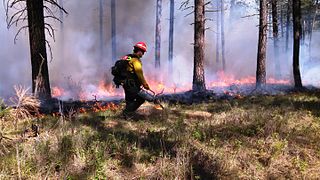
A controlled or prescribed burn, also known as hazard reduction burning, backfire, swailing, or a burn-off, is a fire set intentionally for purposes of forest management, farming, prairie restoration or greenhouse gas abatement. A controlled burn may also refer to the intentional burning of slash and fuels through burn piles. Fire is a natural part of both forest and grassland ecology and controlled fire can be a tool for foresters.

The Leatherstocking Tales is a series of five novels by American writer James Fenimore Cooper, set in the eighteenth century era of development in the primarily former Iroquois areas in central New York. Each novel features Natty Bumppo, a frontiersman known to European-American settlers as "Leatherstocking", "The Pathfinder", and "the trapper". Native Americans call him "Deerslayer", "La Longue Carabine", and "Hawkeye".
This glossary of wildfire terms is a list of definitions of terms and concepts relevant to wildfires and wildland firefighting. Except where noted, terms have largely been sourced from a 1998 Fireline Handbook transcribed for a Conflict 21 counter-terrorism studies website by the Air National Guard.
A driptorch is a tool used in wildfire suppression, controlled burning, and other forestry applications to intentionally ignite fires by dripping flaming fuel onto the ground.
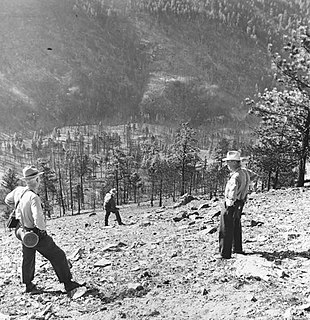
The Mann Gulch fire was a wildfire reported on August 5, 1949, in a gulch located along the upper Missouri River in the Gates of the Mountains Wilderness, Helena National Forest, in the U.S. state of Montana. A team of 15 smokejumpers parachuted into the area on the afternoon of August 5, 1949, to fight the fire, rendezvousing with a former smokejumper who was employed as a fire guard at the nearby campground. As the team approached the fire to begin fighting it, unexpected high winds caused the fire to suddenly expand, cutting off the men's route and forcing them back uphill. During the next few minutes, a "blow-up" of the fire covered 3,000 acres (1,200 ha) in ten minutes, claiming the lives of 13 firefighters, including 12 of the smokejumpers. Only three of the smokejumpers survived. The fire would continue for five more days before being controlled.

Fire ecology is a scientific discipline concerned with natural processes involving fire in an ecosystem and the ecological effects, the interactions between fire and the abiotic and biotic components of an ecosystem, and the role as an ecosystem process. Many ecosystems, particularly prairie, savanna, chaparral and coniferous forests, have evolved with fire as an essential contributor to habitat vitality and renewal. Many plant species in fire-affected environments require fire to germinate, establish, or to reproduce. Wildfire suppression not only eliminates these species, but also the animals that depend upon them.

In the United States, a hotshot crew, formally known as an interagency hotshot crew, is a handcrew of 20-22 wildland firefighters which responds to large, high-priority fires across the country and are assigned to work the most challenging parts of the fire. They have specific qualifications to provide leadership for initial-attack and extended-attack on wildland fires, and are trained and equipped to work autonomously in remote areas for extended periods of time with little or no logistical support. Hotshot crews are the most highly trained, skilled, and experienced type of handcrews. Hotshot crews are organized by agencies such as the United States Forest Service, National Park Service, Bureau of Indian Affairs, Bureau of Land Management, and state and county agencies; the National Interagency Fire Center coordinates hotshot crews on the federal level.

Wildfire suppression is a range of firefighting tactics used to suppress wildfires. Firefighting efforts in wild land areas require different techniques, equipment, and training from the more familiar structure fire fighting found in populated areas. Working in conjunction with specially designed aerial firefighting aircraft, these wildfire-trained crews suppress flames, construct fire lines, and extinguish flames and areas of heat to protect resources and natural wilderness. Wildfire suppression also addresses the issues of the wildland-urban interface, where populated areas border with wild land areas.

Young Men and Fire is a non-fiction book written by Norman Maclean. It is an account of Norman Maclean's research of the Mann Gulch fire of 1949 and the 13 men who died there. The fire occurred in Mann Gulch in the Gates of the Mountains Wilderness on August 5. The book won the National Book Critics Circle Award (1992).
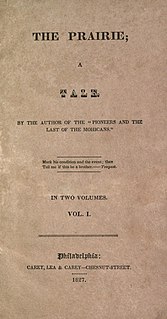
The Prairie: A Tale (1827) is a novel by James Fenimore Cooper, the third novel written by him featuring Natty Bumppo. His fictitious frontier hero Bumppo is never called by his name, but is instead referred to as "the trapper" or "the old man." Chronologically The Prairie is the fifth and final installment of the Leatherstocking Tales, though it was published before The Pathfinder (1840) and The Deerslayer (1841). It depicts Natty in the final year of his life still proving helpful to people in distress on the American frontier. The book frequently references characters and events from the two books previously published in the Leatherstocking Tales as well as the two which Cooper wouldn't write for more than ten years. Continuity with The Last of the Mohicans is indicated by the appearance of the grandson of Duncan and Alice Heyward, as well as the noble Pawnee chief Hard Heart, whose name is English for the French nickname for the Delaware, le Coeur-dur.

Fire-retardant gels are superabsorbent polymer slurries with a "consistency almost like petroleum jelly." Fire-retardant gels can also be slurries that are composed of a combination of water, starch, and clay. Used as fire retardants, they can be used for structure protection and in direct-attack applications against wildfires.
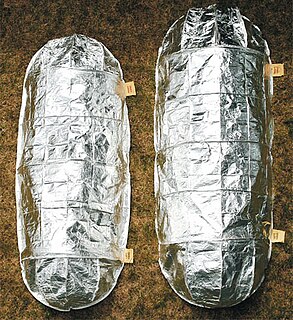
A fire shelter is a safety device of last resort used by wildland firefighters when trapped by wildfires. While such a shelter cannot withstand sustained contact with flames, it can protect a firefighter's life in a short-lived grass fire. Furthermore, it is designed to reflect radiant heat, protect against convective heat, and trap breathable air — most firefighters' deaths are from inhaling hot gases — so that firefighters can survive in non-burning areas surrounded by intense fire for more than an hour.
Earl Cooley (1911–2009) spent his career working in the U.S. Forest Service (USFS), where he was concerned with developing new methods of fighting forest fires. In 1940, he was one of the first U.S. firefighters to parachute from a plane onto a wildfire. Cooley went on to train others to fight fires by smokejumping. After his retirement from the USFS, he set up the National Smokejumper Association, of which he was president from 1993 to 1995.

Escape Fire: The Fight to Rescue American Healthcare is a 2012 feature-length documentary directed by Matthew Heineman and Susan Froemke and released by Roadside Attractions. Escape Fire premiered at the Sundance Film Festival, opened in select theaters on October 5, 2012, and was simultaneously released on iTunes and Video-on-Demand. The film was released on DVD in February 2013 and premiered on CNN on March 10, 2013.

On August 18, 1937, a lightning strike started the Blackwater Fire in Shoshone National Forest, approximately 35 miles (56 km) west of Cody, Wyoming, United States. Fifteen firefighters were killed by the forest fire when a dry weather front caused the winds to suddenly increase and change direction. The fire quickly spread into dense forest, creating spot fires that trapped some of the firefighters in a firestorm. Nine firefighters died during the fire and six more died shortly thereafter from severe burns and respiratory complications. Another 38 firefighters were injured. The fire killed more professional wildland firefighters in the U.S. than any other in the 103 years between the Great Fire of 1910 and the Yarnell Hill Fire in 2013.

The Yarnell Hill Fire was a wildfire near Yarnell, Arizona, ignited by dry lightning on June 28, 2013. On June 30, it overran and killed 19 members of the Granite Mountain Hotshots. Just one of the hotshots on the crew survived—he was posted as a lookout on the fire and was not with the others when the fire overtook them. The Yarnell Hill Fire was one of the deadliest U.S. wildfires since the 1991 East Bay Hills fire, which killed 25 people, and the deadliest wildland fire for U.S. firefighters since the 1933 Griffith Park fire, which killed 29 "impromptu" civilian firefighters drafted on short notice to help battle that Los Angeles area fire.
The Ten Standard Firefighting Orders are a set of systematically organized rules designed by a USDA Forest Service task force to reduce danger to personnel and increase fire fighting efficiency. They were introduced in 1957 and since then only the numbering changed, in order to make them easier to memorize.
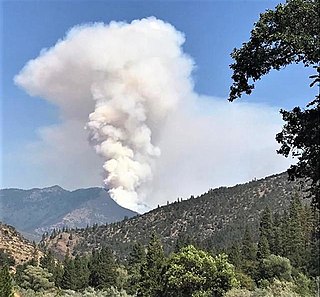
The Lime Fire was a wildfire located west of Interstate 5 and north of Highway 96 in the Klamath National Forest's Lime Gulch area in Siskiyou County. The fire was started as the result of a lightning strike during a thunderstorm. As of September 17, the fire has burned 1,862 acres (754 ha) and is 96 percent contained. Evacuation warnings are in place for the area between Ash Creek and Gottsville, warning to take "extreme caution" along Highway 96. Portions of Klamath National Forest are closed due to the fire.















